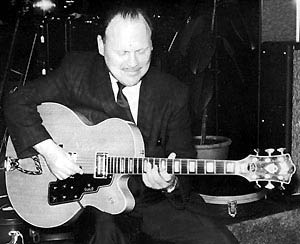This may sound over the top, but I think we will not have a clear idea of how much American popular music of a certain age was soaked in jazz until we have a proper discography (with the names of all musicians involved) of the Columbia and RCA labels, and their subsidiaries. Being those two the biggest labels in the 1950s, it's sort of a wet dream for some of us in all our splendid nerdiness.
Of course music is music, and being able to listen to it should suffice to appreciate all the flavours in it. Still, impressions are affected when you know who's actually playing in whatever record, and it does seem that jazz musicians, or at least musicians with a heavy jazz slant, or big band veterans whose early days were spent playing music with a high jazz-octanage, were everywhere in American popular music from the 50s and 60s. And it's not just Sinatra's albums featuring members of the Stan Kenton ot the Count Basie orchestras. There's much more.
 |
| Barry Galbraith |
This session work being literally a behind-the-scenes activity may leave historians in the dark, but its very anonimity surely helped black musicians getting those jobs. Joe Wilder, Clark Terry, Ernie Royal, Milt Hinton... are among the African-American pioneers in this line of work, which allowed them to live comfortable lives, sometimes with some serious jazz on the side. These musicians are rarely mentioned at all, even though they were, in actual fact, among the best musicians of their era in any style. That's why some time ago I tried to name the musicians in the programme Leonard Bernstein devoted to jazz (CBS, 1955).
By the late 1950s, among the people buzzing around Manhattan, there was a sizeable group of musicians who were as busy as they wished recording all kinds of music. Their routine would involve checking any calls with Radio Registry, an early message service, write down dates, times, contractor names, and the studio, and be there at the allotted time, with the required equipment, ready to sight-read fly shit and play it in the required style and, if possible, be likeable and nice.
 |
| George Barnes (from The George Barnes Legacy website) |
Among his earliest, at the time of the stereo and hi-fi craze around 1960, Barnes did a couple of albums, Guitars Galore and Guitar Galaxies using a guitar choir, a sort of big band section comprised exclusively by guitars. Now, this was some years after Les Paul had his huge hits with multitracked guitars. Still, with multitracking readily available, it seems that the will and the means were there not to multitrack guitars, but have them played by some of the biggest names in the business: Al Caiola, Don Arnone, Everett Barksdale, Art Ryerson, Bucky Pizzarelli, Billy Bauer, Barry Galbraith, Carl Kress... (you can see the last three in the video below).
Besides having a common interest in music, these session musicians would bump into each other all the time, so much so that the guitarists got together, about 40 of them according to Billy Bauer in his memoirs, bought good amplifiers, and left them at the studios so they didn't have to carry them around. With work aplenty, and a strong musical bond, it's not surprising that these people socialized together too.
One such occasion was a listening party at the Barnes's in December 1961. The listening concerned Guitars Galore, his new album at the time. Now, Barnes's daughter has dug out some pictures from the event, and has produced the lovely video below with a track from that album (she's also produced the video above). The guests, many of whom brought their wives, include everyone involved with the album, from musicians, to the now legendary sound engineer, the writer of the liner notes, the head of the guitar company endorsed by Barnes, a friend of their favourite barman to tend the bar... Think Mad Men meet the studio scene.
Enjoy the music, and the images. See if you recognize anyone. More about the party, the pictures, and the people in them, tomorrow.
No comments:
Post a Comment